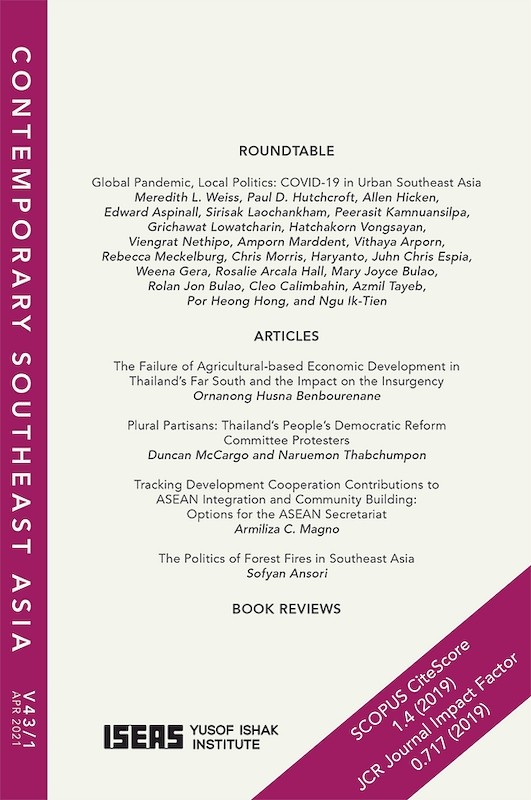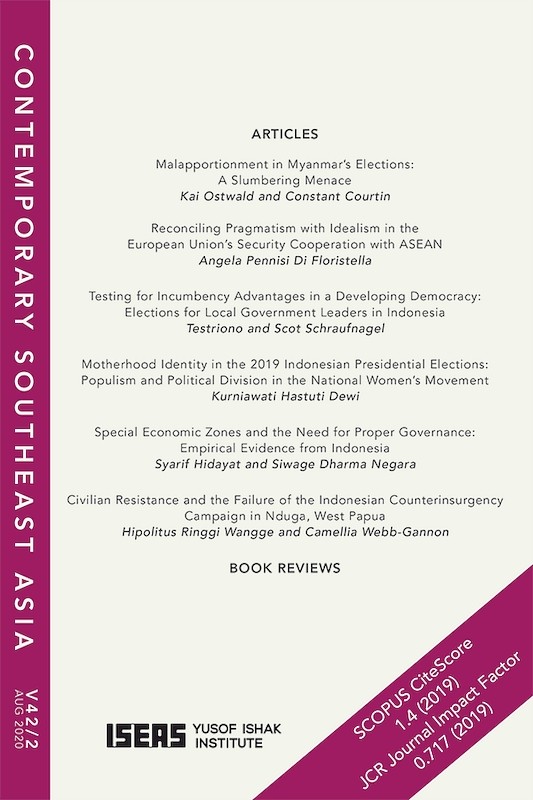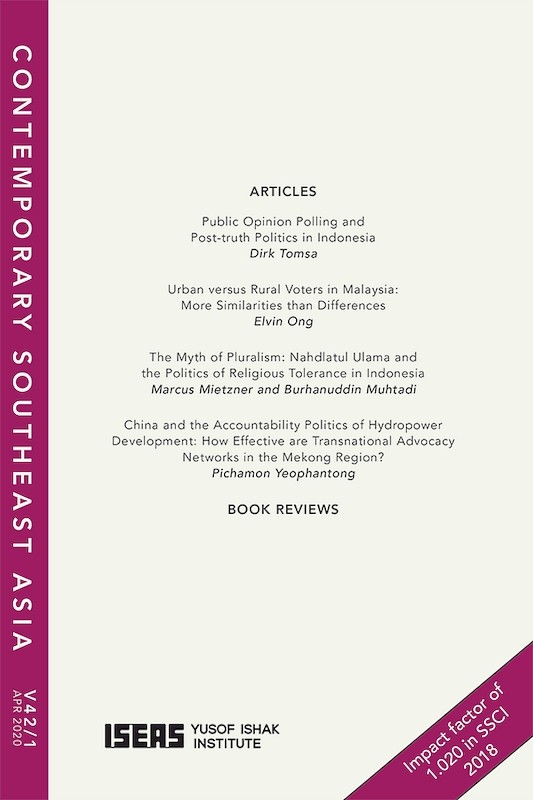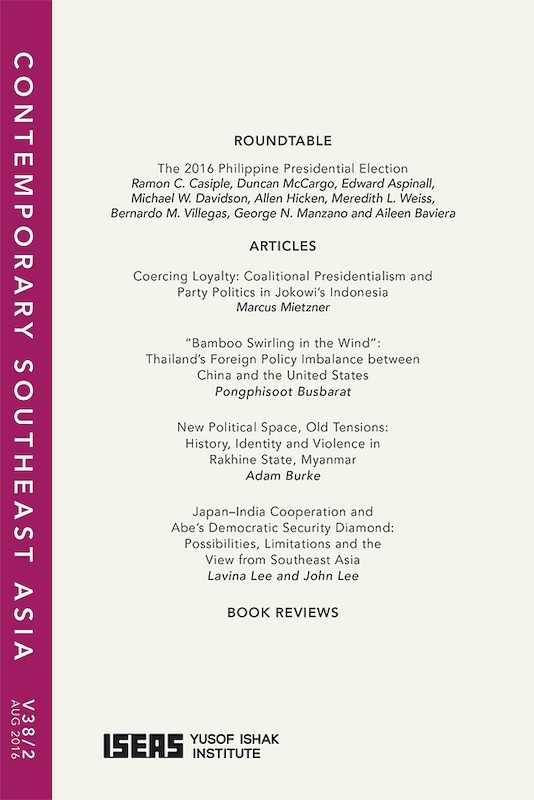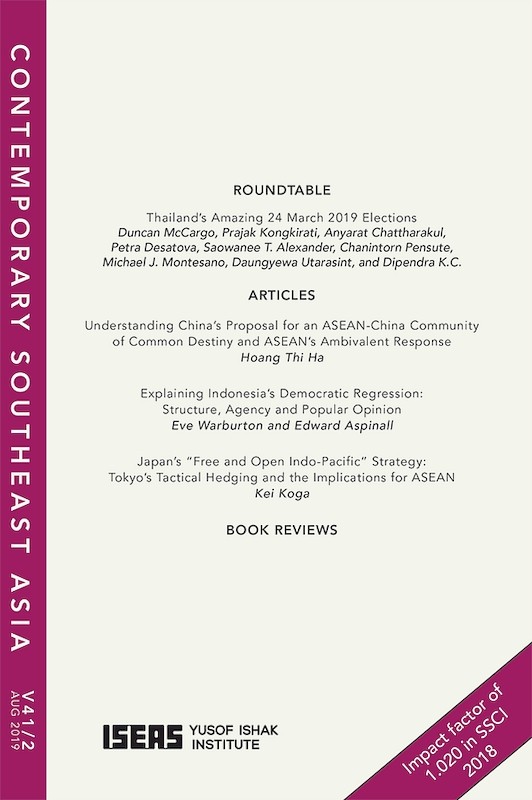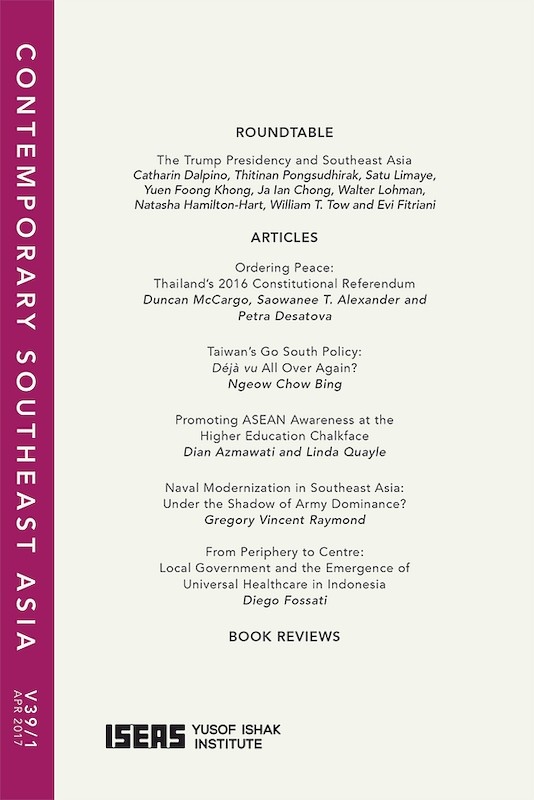Contemporary Southeast Asia Vol. 42/3 (December 2020)

Date of publication:
December 2020
Publisher:
ISEAS – Yusof Ishak Institute
Number of pages:
132
Code:
CS42/3
About the publication
- Attained SCOPUS CiteScore of 1.4 in 2019.
- Attained Journal Citation Report (JCR) Journal Impact Factor of 0.717 in 2019.
- SCImago Journal and Country Rank (SJR) 2019 for the Asiatic Region: Ranked 1st in Political Science and International Relations; 1st in History; and 3rd in Arts and Humanities.
- Ranked 19th by Google Scholar Metrics 2020 in the category of “Asian Studies and History”.
Contents
-
Contemporary Southeast Asia Vol. 42/3 (December 2020)
[Whole Publication, ISSN: 1793284X] -
Preliminary pages
- ARTICLES
-
1. Naming and Shaming China: America’s Strategy of Rhetorical Coercion in the South China Sea, by Wendy He Qingli, Haridas Ramasamy, authors see abstractStates adopt public “naming and shaming” as a rhetorical coercion strategy in-lieu of kinetic force in order to get other countries to comply with accepted norms. However, the effectiveness of this strategy has been uneven and at times has failed to elicit the response desired by the rhetorical coercer. The South China Sea dispute is a good example of rhetorical contestation as an important undercurrent in US-China competition. By tracing rhetorical exchanges—from the Obama administration’s subtle rhetorical coercion to the Trump administration’s overt naming and shaming strategy—this article shows that the US-China rhetorical contestation over the South China Sea has evolved from an initial implication contest into a framing contest, both of which are considered as “unstable outcomes” in rhetorical contestation. Such outcomes show that far from backing down, China has been able to resist and strategically counter American naming and shaming. This was accomplished in three ways. First, by exploiting the ambiguity of the international law frame. Second, by portraying the United States as an “outsider”. Third, by appealing to its audience—the littoral states of Southeast Asia—with a publicly sustainable new narrative.
-
2. Religion as a Tool of Influence: Buddhism and China’s Belt and Road Initiative in Mainland Southeast Asia, by Gregory V Raymond, author see abstractThe material dimensions of China’s Belt and Road Initiative (BRI), which encompass multibillion-dollar investments in transport infrastructure and industrial estates, are expected to make China a key player in the development and increasing integration of mainland Southeast Asia. This article, however, looks beyond trade and hard infrastructure to examine China’s emerging efforts to build influence at the ideational level through the use of Buddhism as a cultural resource. It documents government-sponsored outreach to Southeast Asia’s Buddhist leaders and communities in Thailand, Myanmar, Cambodia and Laos. It finds that there has been a surge in outreach from a range of Chinese provinces since the advent of the BRI in 2013. These outreach efforts warrant categorization as influence operations because they are orchestrated through the offices of the United Front Work Department, are being used to promote China’s political goals, and are sanctioned by a party that remains staunchly atheist and forbids its members to practise religion. In broader terms, China’s use of Buddhism as an adjunct to the BRI in mainland Southeast Asia suggests it is seeking to dampen disquiet about the BRI, including by fostering a sense of shared values with mainland Southeast Asian states.
-
3. Resolving Land-Use Conflicts over Indonesia’s Customary Forests: One Map, Power Contestations and Social Justice , by Laely Nurhidayah, Peter J Davies, Shawkat Alam, authors see abstractIndonesia’s One Map Policy aims to produce a standardized and single map which can clarify and provide a consistent record of land tenure with a view to resolving land-use conflicts in the forestry sector. The implementation of this policy has faced many challenges, including contestations over land ownership, uncertainty over the status of indigenous customary lands and other procedural obstacles associated with generating a single master map. While significant parts of Indonesia’s forests are owned and managed by indigenous peoples, this has not always been uniformly recognized across different legal jurisdictions. This is slowly changing following a 2012 Constitutional Court decision to formally recognize customary indigenous lands and forests. Despite this ruling, obstacles remain in rectifying past practices and decisions as well as streamlining the complex array of forestry governance arrangements currently applied throughout Indonesia. This article suggests the resolution of land-use conflicts within the forestry sector must be premised on principles of forest sustainability, which must include addressing the social justice concerns of indigenous peoples and local communities as well as improving their capacity to manage customary forests.
-
4. Green in the Heart of Red: Understanding Phayao Province’s Switch to Palang Pracharat in Thailand’s 2019 General Election, by Joel Sawat Selway, author see abstractWhat explains the loss of support for Pheu Thai in the March 2019 general election in Thailand? Based on 234 semi-structured interviews with voters in the province of Phayao in northern Thailand, this article explores the military’s efforts to undermine popular support for Pheu Thai. Phayao is an illuminating case because it surprisingly switched to the military’s party, Palang Pracharat, in the 2019 election despite having voted for Pheu Thai and its predecessor parties in the previous six elections. The article finds that although Phayao voters still feel a strong sense of loyalty towards Pheu Thai, a combination of three factors—Palang Pracharat’s policy adaptations, voters’ practical considerations and voters’ personal ties with individual candidates—eventually led them to switch their support to Palang Pracharat. Nevertheless, the deeply-ingrained partisanship for Pheu Thai among voters suggest that this party will likely remain a formidable force in Thai politics for the foreseeable future.
- BOOK REVIEWS
-
BOOK REVIEW: Under Beijing’s Shadow: Southeast Asia’s China Challenge, by Murray Hiebert, by John D Ciorciari, author
-
BOOK REVIEW: In the Dragon’s Shadow: Southeast Asia in the Chinese Century, by Sebastian Strangio, by Malcolm Cook, author
-
BOOK REVIEW: Man of Contradictions: Joko Widodo and the Struggle to Remake Indonesia, by Ben Bland, by Yanuar Nugroho, author
-
BOOK REVIEW: India’s Eastward Engagement: From Antiquity to Act East Policy, by S.D. Muni and Rahul Mishra, by Yanitha Meena Louis, author
-
BOOK REVIEW: ‘Observing’ the Arctic: Asia in the Arctic Council and Beyond, edited by Chih Yuan Woon and Klaus Dodds, by Marc Lanteigne, author
-
BOOK REVIEW: Civil-military Relations in Indonesia: The Politics of Military Operations Other Than War, by Muhamad Haripin, by Natalie Sambhi, author

